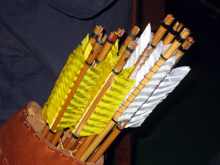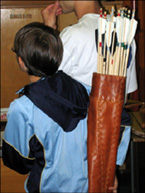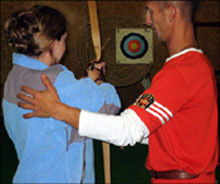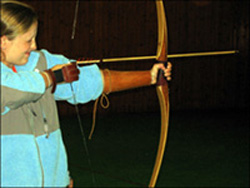|
Cagliese
archers practice their form in a local gymnasium.
|
|
 |
Italian archery requires few things:
the traditional bow, a handful of €5 arrows, complete
concentration, and possibly the number for your local
seamstress.
Just make sure to leave your wife at
home.
The archery club, Arcieri dell’Oca,
also known as the Archers of the Goose, formed in February
2003 after the summertime festival in Cagli demanded
that more historically revived games be played. A group
of 17 men — 16 adults and one six-year old —
created the group in the name of history, and they have
been practicing three nights per week ever since.
And women are not invited to participate.
|
|
|
|
“Their aim stinks,” joked club member Fabrizio
del Re, who is commonly referred to as “Grandine,”
which means “hail storm.”
But the “goose archers” claim that their organization
is all-male for traditional purposes: there were no female
soldiers during the Middle Ages, the time period that the
archery tradition is based on.
The all-male group meets regularly in the middle-school gymnasium
in Cagli, a partially walled, medieval city in the Marche
region of Italy. The sound of arrows piercing the primary-colored
targets bounces from the green rubber floor and echoes off
the wooden-paneled walls in the grimy gym. The brightly lit,
single-room building — crucial for allowing complete
focus and precise aim — is filled with Italian chatter
and men who, if only temporarily, mean all business.
After bad shots, the men often tease each other, and they
compliment each other after accurate ones.
The usually exact team captain, Goffredo Ciancarmela, 36,
is taunted by the sounds of booing and laughter from his teammates
after his shot ricochets off the target and crashes into the
adjacent wall.
Ciancarmela shrugs off their teasing and winds up again.
This time, his shot is nearly perfect.
During regular practice hours, the men wear casual t-shirts
and broken-in jeans. The costumes worn during actual competitions,
however, consist of a white shirt under a brown blouse, red
felt shorts, black tights, and tan gloves and boots. A female
seamstress in Cagli, the mother of one of the archers, constructs
the costumes, which are based on a painting of an archer by
a Cagliese artist of the 1500s known as Gaetano Lapis.
The Arcieri dell’Oca team members find importance
in copying the yellow-feathered arrows and the long-wooden
bows details of Lapis’ painting. When the men grew serious
about pursuing archery and keeping this medieval tradition
alive, Ciancarmela gave Lapis’ design to the seamstress
who created their idea of the ideal costume.
|
 |
| Arrows
used in practice
|
|

|
|
|
|

Author
Ann Curran is shown proper technique
|

Ann
Curran carefully aims at her target
|
|
The men also tie brown bands to their arms and wear gloves
during practices and competitions to protect their skin from
the snapping bow. These leather bands and gloves are provided
by the Associazione Giochi Storici, the historical
sports association.
Practice is a time for the men to perfect their shots and
catch up with friends, as long as they have paid the one-time
insurance coverage fee of €25.
The men pay for their own bows and arrows when needed. Ciancarmela
orders whatever the team is lacking from the Associazione
Giochi Storici in bulk in order to save money on the
shipping.
On a recent chilly June evening, Ciancarmela jokingly badgered
his team to pay for the equipment they needed. The others
protested and whined, kidding along with their leader.
“I feel like nobody listens to me!” laughed Ciancarmela.
“When I say money, they all turn and run.”
Ciancarmela has been involved with archery for three years,
ever since he volunteered to organize a traditional game for
the annual summertime festival, Palio dell’Oca
when the small town’s main piazza transforms into a
giant gameboard.
“His leadership and good aim earned him the title,”
Stefano Barzotti, an original member of the team, explained.
“He has done a great job being a leader.”
In June 2004, Arcieri Dell’oca won the Italian
Championship in historical archery, topping 16 teams. The
competition was not held in one specific place, but rather
throughout eight different cities in central Italy. At that
time, the Cagli team was less than a year old.
|
|
| This year’s
historical competition will be held in one place: Cagli.
“My favorite part about archery is going out and traveling
to other cities,” explained Barzotti, 32, better known
as Picchio, “woodpecker,” to his teammates.
Barzotti, a bartender and the second-ranked archer on the
squad, recognizes the importance of keeping this tradition
alive. He brings his son Riccardo, 6, to practices, and he
adamantly teaches him about the tradition.
“This sport is a historical revival,” says Barzotti.
“The competition is important, but the driving factor
is tradition.”The Associazione Giochi Storici,
which supplies the team with the proper equipment, charges
about €170 for a bow, while a hand-made one can cost
as much as €750. Arrows are only €5 each, but owning
a dozen or more can also become quite pricey.
However, most team members, similar to Barzotti, believe
their newfound hobby is a great investment.
“Archery requires concentration, instinct, and a little
bit of luck,” Barzotti says. “It’s also
a fun hobby and a way to make friends.”
|
|
|
|

